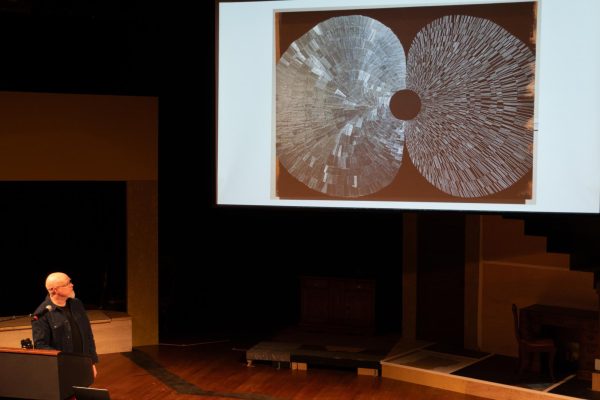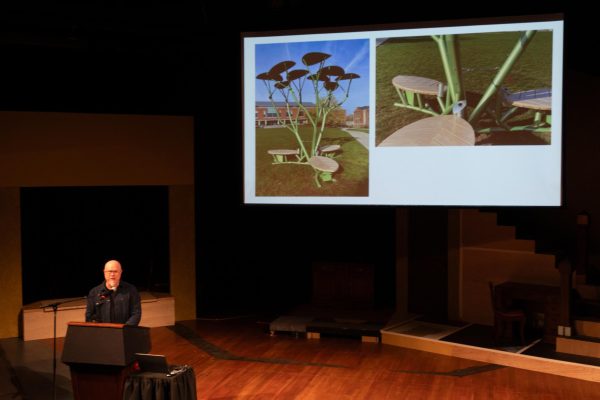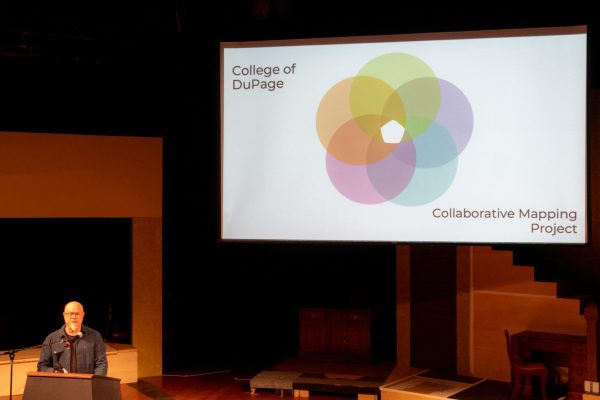We often think of art and science as remotely different disciplines. Artist and designer Chris Sancomb fuse the two harmoniously in ways that allow people to learn and interact with abstract scientific concepts through art.
An educator based in Rhode Island holding a rich artistic background, he was recently invited to College of DuPage to showcase his artistic background and work.
Acer Esparza, a philosophy student at College of DuPage, attended the event. She was motivated to attend the event partly as a result of currently taking an art class as well as the large expected turnout she had heard of prior. She was interested in hearing the viewpoints of an artist who works with different mediums and explores novel concepts.
“I was hearing a lot of people, different people from different classes doing different things, were all going to be here,” she said. “People from sculpting classes were here. I knew people from all over the school were coming here to learn about this. So I’ve just been really interested to see what kind of perspectives people would have based off of whatever things they specialize in.”
Sancomb’s pieces explore scientific concepts that are sometimes difficult to conceptualize, such as space and celestial object activity.
“I like thinking about things that are sort of difficult to comprehend and difficult to study,” he said. “I find meaning in unpacking these ideas through making and through visualizing. For me, it’s a form of understanding. A lot of the work that I do more recently has been kind of evolving out of thinking about these things that are not visible in our spectrum of eyesight, that are only theoretical, that are too distant, too big.… They’re just interesting ideas.”

Sancomb works with diverse mediums, including sculpture, 2-D art and 3-D digital art.
“Along with drawing by hand, I work digitally as well,” he said. “In some of the digital work, I like to think about the ways in which actual data might be able to be used to create form using things like waveforms or numeric data to influence the creation of shape that then goes into a piece that starts to develop a concept around an idea.”
Using 3-D modeling techniques based on numeric data, he created a 3-D model of gravitational waves discovered by scientists that indicated the detection of large black holes in the galaxy.
“I was really interested in the discovery of gravitational waves in 2015, something that Einstein had predicted over 100 years ago,” he said. “Which was only made possible through newer technology that emerged in 2015. They accidentally caught a reading of two supermassive black holes. ”
Esparza was fascinated by Sancomb’s diverse experience in a wide range of mediums.
“The variety of mediums that he uses for a lot of his pieces were probably the most surprising to me,” she said. “Hearing first hand how people do it and what the process looks like [is fascinating].”
Using that 3-D model, he set off to carve a large marble sculpture, partially with the help of a carving robot for precision, at the Digital Stone Project in Italy last summer, entitling it “Every Star Eclipsed at the Same Time.”
Sancomb took a moment to explain his artistic background and how he was inspired to incorporate science significantly in his artwork. After working for a furniture company that shut down, he called a local museum looking for work and was hired as a mount maker, aiding in the formation of the display of exhibit objects.
“I had metal working experience,” he recalled. “So this unique skill that I had learned in art school and a phone call brought me into a completely new career path that I wasn’t even aware of. I had been to a lot of museums and had not really spent the time to think about how museum exhibits come together particularly art museums.”
When the museum he worked at began to plan a new exhibit about mummies, they enlisted Sancomb’s artistic and design skills that others could not contribute to the new exhibit’s design.
This exhibit-in-progress significantly differed from the types of exhibits Sancomb was acquainted with creating mounts for.
“Everything about that museum was hands-on and interactive,” Sancomb explained. “There were no objects in cases. There was nothing that was essentially out of bounds, and it was not a very didactic museum in the sense that they wanted to teach a very, very specific thing. What they wanted you to do is to learn through doing.”
Soon, he was commissioned to design more hands-on exhibits for other museums, including an interactive water exhibit for a local children’s museum, which involved collaborating with others holding backgrounds in diverse fields of study.
“I redesigned the major water exhibit, which involved working with a lot of hydraulic engineers, working with health and safety officials intersecting with parts of the business world that I hadn’t ever worked in,” Sancomb said. “But also [involved] thinking about ‘What’s fun about water? How do we play with water, how do we interact with water?’”
Sancomb’s work in museums inspired him to continue creating interactive designs that unite communities and encourage deeper thinking.
“Because of my museum work, I became quite interested in designing with and for the public and particularly for public interaction and for public good,” he stated. “I [am] interested in designing things that create community spaces for people to gather spaces for people to celebrate shared space.”
In 2019, he became an art and industrial design professor at the University of Connecticut..He was eager to connect with professionals in various fields of study, like physicists and social scientists, to attain inspiration and collaborate with them on his work.
Among his most recent works involving his goals to create interactive, community exhibits is a “Solar Tree,” an outdoor solar-panel powered seating area that allows people to sit next to one another as well as recharge electronic devices. Sancomb created the Solar Tree in collaboration with an electrical engineer, a material sciences engineer, a biologist and an urban studies professor.
“It stands about 15 feet high,” he said, describing the Tree. “It has nine solar panels on it. Each of those benches has a charging station that’s built into it that hosts multiple USB ports. And then underneath those benches. Our batteries and control units and so this is when it was first installed out on the campus at the University of Connecticut.”

The interactive project was well-received as the center of a social environment, attracting people to sit in the shade, read books, recharge their phones, work on their laptops and exchange conversations under the Tree.
According to Sancomb, the Solar Tree is set to be made available in various other public outdoor spaces in the New England region in later months.
Sancomb emphasized the value of cooperation and collaboration to contribute to work, using a creative visual to convey his point.

“I feel like this diagram really represents a little bit more of what I think of as collaboration,” he said. “All of these ideas coming together and that sweet spot in the middle. That new shape is created by the merging of all these ideas. That is where collaboration really exists and thrives. And it takes work. It takes dedication and it takes sort of attention to that space to make collaboration.”
He also shared another philosophy of his regarding the creative process: the power of play.
“Play is something that I feel like is really, really important that we may have left behind in a certain way,” he affirmed. “But I think as a creative, it is an absolutely essential part of our creative practice to remind yourself to be playful, to leave space for play. It doesn’t necessarily look childish, but it does contain some of the qualities of that childlike play in terms of setting yourself free, perhaps a suspension of disbelief that is required to really engage with some of your work.”
Esparza felt inspired by Sancomb’s philosophies on the creative process, which encouraged her to view art from a novel perspective.
“I found them to be pretty eye-opening,” she said. “And an interesting way of thinking that I never thought of before. it made me think of different ways to express myself through art.”
More information about Chris Sancomb and his artwork can be found on his website.









